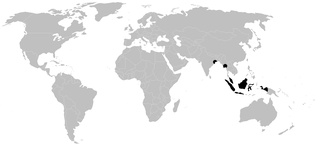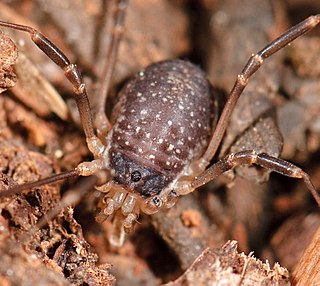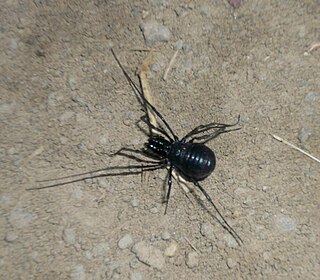
The Opiliones are an order of arachnids, colloquially known as harvestmen, harvesters, harvest spiders, or daddy longlegs. As of July 2024, over 6,650 species of harvestmen have been discovered worldwide, although the total number of extant species may exceed 10,000. The order Opiliones includes five suborders: Cyphophthalmi, Eupnoi, Dyspnoi, Laniatores, and Tetrophthalmi, which were named in 2014.

The Sironidae are a family of harvestmen with more than 60 described species.

The Stylocellidae are a family of harvestmen with about 40 described species, all of which occur in Southern or Southeastern Asia. Members of this family are from one to seven millimeters long. While Stylocellus species have eyes, these are absent in the other two genera.

Ischyropsalididae is a family of harvestmen with 35 described species in 3 genera, found in Europe and North America.

Epedanidae is a family of the harvestman infraorder Grassatores with about 200 described species. They are the sister group of the Gonyleptoidea.

The Cranaidae are a family of neotropical harvestmen within the suborder Laniatores.
Escadabiidae is a small neotropical family of the harvestman infraorder Grassatores with six described species.

Podoctidae is a family of the harvestman infraorder Grassatores with about 130 described species.
Yania is a genus of harvestmen from South America. Yania flavolimbata is the only species in the monotypic genus Yania. It was first described by Roewer, 1914.
Eutimesius is a genus of harvestmen in the family Stygnidae with five described species. All species are found in South America.

Globipes is a genus of harvestmen in the family Globipedidae from North America with three described species. Two are found on the western coast of the USA.
Zalmoxis is a genus of harvestmen, within the Zalmoxidae family. They are found in tropical Australia, Borneo, New Guinea, the Philippines and on Pacific islands.

Ischyropsalis is a genus of harvestmen in the monotypic family Ischyropsalididae, with 24 described species. They are found in Europe.
Acropsopilionoidea is a superfamily of harvestmen with 1 family and 3 genera, found in North America and the Southern Hemisphere.

Rakaia is a genus of harvestmen in the family Pettalidae with eighteen described species. All species are found in New Zealand.
Bourguyia is a genus of harvestmen in the family Gonyleptidae with four described species. All species are found in Brazil.

Poecilaemula is a genus of harvestmen in the family Cosmetidae with eight described species. All species are from Central America or South America. An overview of the taxonomy was provided by Medrano et al. (2024)
Poecilaemula signata is a species of harvestmen from Central America in the family Cosmetidae. It was first described by Banks in 1909.
Tithaeidae is a family of the harvestman infraorder Grassatores, Epedanoidea with about 40 described species.
Abria is a genus of harvestmen in the family Cosmetidae with three described species. All species are from Venezuela. An overview of the taxonomy was provided by Villarreal, Medrano & Kury (2023)










